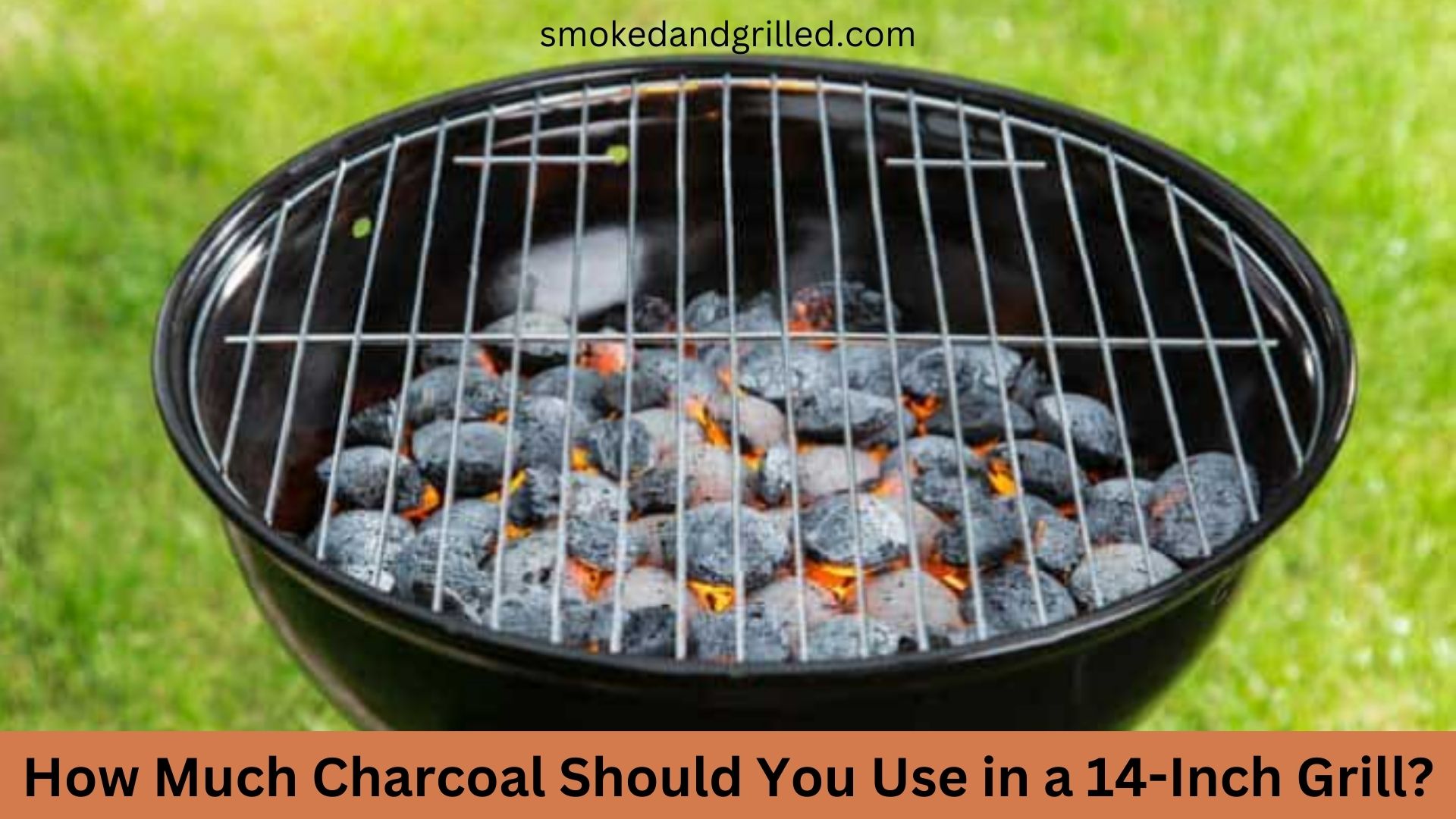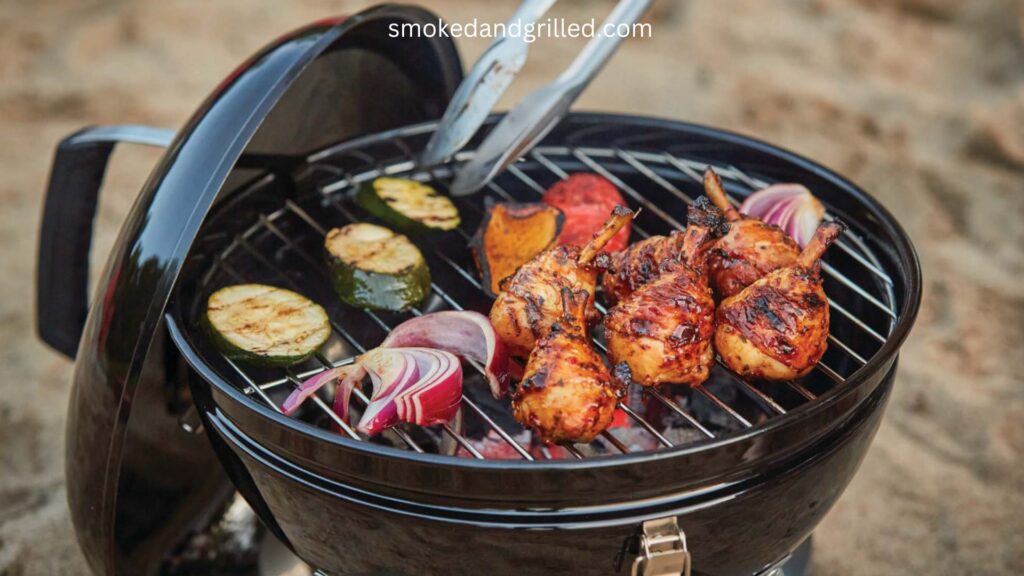People who like to grill get together! Are you ready to find out what your 14-inch grill is hiding? One question that often comes up is how much charcoal to use.
Don’t worry. We’ve got a tasty answer. We’ve got you covered whether you like direct heat, indirect heat, or even if you’re a smoking master.
Get ready to turn up the heat on your grill and take your outdoor cooking to a whole new level. Let’s cook and have fun!
Also Read:
- How To Smoke Ribs On a Charcoal Grill [Complete Recipe]
- Smoking Pork Butt on Pellet Grill – Complete Guide!
How Much Charcoal Should You Use In A 14-Inch Grill?
When using charcoal in a 14-inch grill, how much you need depends on a number of things, like how you want to cook, the type of charcoal you use, and the weather.
When figuring out how much charcoal to use, the size of the grill is one of the most important things to think about. Since a 14-inch grill isn’t very big, you won’t need as much charcoal as you would for a bigger one.
Too much charcoal can make the fire too hot, making it hard to control the heat and possibly leading to food that is overcooked or burned.
How much you need also depends on the type of charcoal you choose. Charcoal briquettes tend to burn hotter and faster than lump charcoal made from hardwood.
Because of this, you may need less hardwood lump charcoal than briquettes to get the same amount of heat. If you’re using a particular type of charcoal, it’s always a good idea to check the manufacturer’s suggestions or follow specific instructions.
Another thing to think about is how you plan to cook the food.
On the other hand, cooking with indirect heat requires lower temperatures and longer cooking times, so you may need less charcoal. Change the amount depending on how you plan to cook and how long it will take to cook your dish.
The rate at which charcoal burns can also be affected by the temperature and wind. In colder weather, you may need more charcoal to make up for heat loss and keep the cooking temperature where you want it.
It’s essential to keep in mind that these guidelines are just a starting point. You may need to change the amount depending on how you grill and what you like. It’s always best to start with a moderate amount of charcoal and add or take away as needed as you grill.
You’ll get a better idea of how much charcoal to use for your 14-inch grill, and the different kinds of cooking you do as you use it and learn from your mistakes.
Different Kinds Of Charcoal
When grilling or barbecuing, choosing the right kind of charcoal can make a big difference in how the food tastes and how the cooking goes overall. Here are some of the most common types of charcoal:
Lump Charcoal From Hardwood
This type of charcoal is made from only hardwood and is liked by many people who like to grill. It burns quickly and hotly, making natural smoke flavors with no chemicals or additives.
Hardwood lump charcoal is known for being able to heat up quickly, which makes it great for searing and getting that smoky flavor that everyone wants.
Charcoal Briquettes
Briquettes are easy to find and don’t cost much. They are made from a mixture of compressed charcoal and things like sawdust, coal dust, or starch that help them light and stay together.
Compared to lump charcoal, briquettes burn longer and more evenly, which makes them suitable for low and slow cooking.
Coconut Shell Charcoal
This option is good for the environment because it is made from coconut shells that have already been used. It burns hotter and for longer than regular charcoal, and it smells mild and nice.
Coconut shell charcoal is known for burning cleanly, so people who care about the environment often use it.
Binchotan Charcoal
Binchotan charcoal comes from Japan and is valued for its high quality and ability to burn for a long time. It is made with oak or other hardwoods, and the process of making it is very careful.
Binchotan charcoal burns at a steady, controlled temperature. This makes it suitable for grilling delicate foods and gives them a unique flavor.
Flavored charcoal is charcoal that has been mixed with aromatic woods like mesquite, apple, hickory, or cherry to give it a stronger flavor. These charcoals give your dishes a distinct smokiness that makes the overall taste better.
What Is The Best Option for a 14-inch grill?
Hardwood lump charcoal is the best way to cook on a 14-inch grill. This is why:
1. Size and Heat
Hardwood lump charcoal usually comes in different sizes, so you can pick pieces that are the right size for your smaller grill. It starts to burn quickly and heats up faster than other types of charcoal.
This makes it easy to spread the heat around the small cooking area.
2. Natural Flavour
Hardwood lump charcoal is made from pure hardwood with no chemicals or other additives. This means your grilled foods will have a clean, natural smoke flavor that will make them taste and smell better.
3. Versatility
Hardwood lump charcoal can be used for many different kinds of grilling because it burns hot and quickly.
Hardwood lump charcoal gives you the heat intensity and control you need to get the results you want when searing steaks, grilling vegetables, or cooking delicate seafood.
4. Quick Cleanup
Since hardwood lump charcoal is made of nothing but natural materials, it makes less ash than briquettes. This makes it easier and faster to clean up after you’re done grilling.
Factors Affecting Charcoal Quantity
When figuring out how much charcoal to use for a grill, there are several things to consider. These factors include the size of the grill, the way you want to cook, the temperature, the wind, and how long you want to grill for.
The size of the grill is a crucial thing to think about because it has a direct effect on how much heat it makes.
A 14-inch grill, for example, needs a lot less charcoal than a bigger grill.
How you cook also affects how much charcoal you need. When cooking food directly over the heat source, which is called direct heat grilling, you usually need more charcoal to get the temperature up quickly.
On the other hand, indirect heat grilling uses less charcoal because the heat is spread out, and the food cooks more slowly.
The rate at which charcoal burns can be affected by the temperature and wind. In colder weather, you may need more charcoal to make up for heat loss.
When it’s windy, charcoal burns faster, so you may need to change how much you use to keep the temperature where you want it.
When cooking for longer periods, you may need to add more charcoal to keep the heat at the level you want.
Taking these things into account and making the right changes will help you figure out how much charcoal you need for a successful grilling experience. It’s best to start with a moderate amount of charcoal and make changes based on how the grilling is going and what you like.
How To Adjust The Charcoal Quantity Based On The Desired Cooking Method
Consider the following rules when deciding how much charcoal to use based on how you want to cook:
For the best grilling results, you need to adjust the amount of charcoal based on how you want to cook. Here are some tips on how to make those changes:
For direct heat grilling, where you need high heat to cook quickly, you’ll need to add more charcoal.
Adding more charcoal will make the heat stronger, giving the food a good sear and char. Put a single layer of charcoal on the charcoal grate to make a concentrated heat source.
Use a moderate amount of charcoal to keep the temperature low and steady while you’re cooking.
Put the charcoal on one side of the grill and leave the other side empty. This setup makes two cooking areas, with direct heat on one side and indirect heat on the other.
By changing the amount of charcoal based on how you want to cook, you can control the amount of heat and get the style of cooking you want.
Make sure to keep a close eye on the cooking process and make any changes that are needed to keep the food at the right temperature while grilling.
The Rule of Thumb
When it comes to charcoal, the rule of thumb is to use one pound of charcoal for every pound of food. This rule helps make sure that your grilling experience is well-balanced. For example, if you have 4 pounds of food, you would try to use about 4 pounds of charcoal.
By following this rule, you can make sure you have enough charcoal to cook the amount of food you want to cook.
It gives a general idea of how much is needed, taking into account the size of the grill and how long it will take to cook.
Experimenting and cooking a lot will help you find the right amount of charcoal for your grilling needs and get the results you want.
FAQ’s
What Happens If You Use Too Much Charcoal On A 14-Inch Grill?
When using an excessive amount of charcoal, which can result in excessive heat, it can be difficult to control and keep the temperature at the desired level while cooking.
The intense heat may quickly sear the exterior of the food, leaving the interior uncooked, which can result in food that is either overcooked or burned. This can happen because the exterior of the food is seared too quickly.
Is It Possible To Use Too Little Charcoal?
If you use too little charcoal, the fire may not get hot enough, which will cause the cooking process to take longer and make it more challenging to achieve the desired char or sear on the food.
Additionally, it may have an impact on the quality of the cooking experience as a whole and lead to less flavorful grilled dishes.
Can You Overcook Food If You Use Too Much Charcoal?
Yes, it is possible to overcook food by using an excessive amount of charcoal if the high heat is not properly regulated or if the food is not monitored closely while it is being cooked.
This happens when the food is not watched closely enough while it is being cooked. It is essential to strike a balance between the quantity of charcoal that is used and the amount of time that is needed to properly cook the particular dish that is being prepared.
How Often Should More Charcoal Be Added To A Grill?
The amount of charcoal that should be added to your grill on a regular basis is determined by a number of different factors, including the total amount of charcoal that was used initially and the configuration of your grill in its entirety.
When the amount of fuel that is currently being used is getting low, or when there is a requirement for additional heat, you can add more charcoal as a general rule.
This can change depending on the cooking method, the temperature of the surrounding air, and the dimensions of your grill.
It is recommended that the charcoal level be monitored throughout the process of grilling and that additional charcoal be added as required in order to keep the heat consistent.
Conclusion
Becoming an expert griller requires, first and foremost, gaining a command of the art of charcoal management and placement.
Understanding the factors that influence the charcoal quantity, as well as the various cooking methods, is essential if you want to achieve the best results possible when using a grill of any size, whether it is 14 inches in diameter or any other size.
You are well on your way to becoming a grilling virtuoso now that you have these tips and strategies at your disposal.
The best way to impress your guests and delight your taste buds is to fire up your 14-inch grill, lean into the crackling flames, and allow the aromatic flavors of perfectly grilled food to do their work. Happy grilling!



